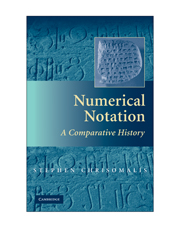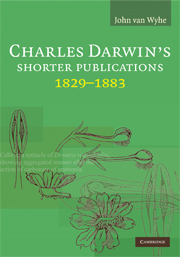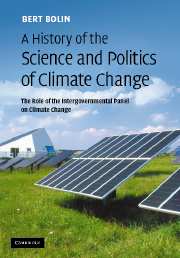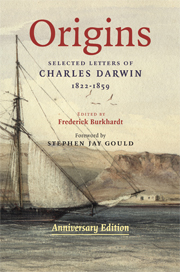Refine search
Actions for selected content:
10306 results in History of science: general interest
John Holmes, Darwin's Bards: British and American Poetry in the Age of Evolution. Edinburgh: Edinburgh University Press, 2009. Pp. xiv+288. ISBN 978-0-7486-3940-3. £60.00 (hardback).
-
- Journal:
- The British Journal for the History of Science / Volume 43 / Issue 2 / June 2010
- Published online by Cambridge University Press:
- 14 June 2010, pp. 305-306
- Print publication:
- June 2010
-
- Article
- Export citation
Michael Lynch, Simon A. Cole, Ruth McNally and Kathleen Jordan, Truth Machine: The Contentious History of DNA Fingerprinting. Chicago and London: University of Chicago Press, 2009. Pp. xxii+389. ISBN 978-0-226-49806-5. £22.00 (hardback).
-
- Journal:
- The British Journal for the History of Science / Volume 43 / Issue 2 / June 2010
- Published online by Cambridge University Press:
- 14 June 2010, pp. 319-320
- Print publication:
- June 2010
-
- Article
- Export citation
Robert Bartlett, The Natural and the Supernatural in the Middle Ages. Cambridge: Cambridge University Press, 2008. Pp. x+170. ISBN 978-0-521-70255-3. £17.99.
-
- Journal:
- The British Journal for the History of Science / Volume 43 / Issue 2 / June 2010
- Published online by Cambridge University Press:
- 14 June 2010, pp. 291-292
- Print publication:
- June 2010
-
- Article
- Export citation
G. Richard Delisle, Les Philosophies du néo-darwinisme. Preface by Jean Gayon. Paris: Presses universitaires France, 2009. Pp. 456. ISBN 978-2130566267. Canadian $56.70 (paperback).
-
- Journal:
- The British Journal for the History of Science / Volume 43 / Issue 2 / June 2010
- Published online by Cambridge University Press:
- 14 June 2010, pp. 315-317
- Print publication:
- June 2010
-
- Article
- Export citation
Denise Gigante, Life: Organic Form and Romanticism. New Haven and London: Yale University Press, 2009. Pp. xiii+302. ISBN 978-0-300-13685-2. £27.95 (hardback).
-
- Journal:
- The British Journal for the History of Science / Volume 43 / Issue 2 / June 2010
- Published online by Cambridge University Press:
- 14 June 2010, pp. 303-305
- Print publication:
- June 2010
-
- Article
- Export citation
Laura Dassow Walls, The Passage to Cosmos: Alexander von Humboldt and the Shaping of America. Chicago and London: University of Chicago Press, 2009. Pp. xv+404. ISBN 978-0-226-87182-0. £24.00 (hardback). - H. Walter Lack, Alexander von Humboldt and the Botanical Exploration of the Americas. London: Prestel, 2009. Pp. 278. ISBN 978-3-79134142-2. £125.00 (hardback).
-
- Journal:
- The British Journal for the History of Science / Volume 43 / Issue 2 / June 2010
- Published online by Cambridge University Press:
- 14 June 2010, pp. 302-303
- Print publication:
- June 2010
-
- Article
- Export citation
Anne Harrington, The Cure Within: A History of Mind–Body Medicine. New York and London: W.W. Norton & Company, 2008. Pp. 336. ISBN 978-0-393-06563-3. £19.99 (hardback).
-
- Journal:
- The British Journal for the History of Science / Volume 43 / Issue 2 / June 2010
- Published online by Cambridge University Press:
- 14 June 2010, pp. 320-322
- Print publication:
- June 2010
-
- Article
- Export citation
Heredity reconceived?
-
- Journal:
- The British Journal for the History of Science / Volume 43 / Issue 2 / June 2010
- Published online by Cambridge University Press:
- 14 June 2010, pp. 277-282
- Print publication:
- June 2010
-
- Article
- Export citation
Peter Ayres, The Aliveness of Plants: The Darwins at the Dawn of Plant Science. London: Pickering & Chatto, 2008. Pp. xiii+227. ISBN 978-1-85196-970-8. £60.00 (hardback). - David Kohn, Darwin's Garden: An Evolutionary Adventure. New York: New York Botanical Garden, 2008. Pp. 60. ISBN 978-0-89327-970-7. $17.99.
-
- Journal:
- The British Journal for the History of Science / Volume 43 / Issue 2 / June 2010
- Published online by Cambridge University Press:
- 14 June 2010, pp. 306-308
- Print publication:
- June 2010
-
- Article
- Export citation

Numerical Notation
- A Comparative History
-
- Published online:
- 18 May 2010
- Print publication:
- 18 January 2010
Synthetic technocracy: Dutch scientific intellectuals in science, society and culture, 1880–1950
-
- Journal:
- The British Journal for the History of Science / Volume 44 / Issue 1 / March 2011
- Published online by Cambridge University Press:
- 14 May 2010, pp. 89-113
- Print publication:
- March 2011
-
- Article
- Export citation

Charles Darwin's Shorter Publications, 1829–1883
-
- Published online:
- 03 May 2010
- Print publication:
- 19 March 2009

A History of the Science and Politics of Climate Change
- The Role of the Intergovernmental Panel on Climate Change
-
- Published online:
- 03 May 2010
- Print publication:
- 15 November 2007

Origins
- Selected Letters of Charles Darwin, 1822–1859. Anniversary edition.
-
- Published online:
- 15 April 2010
- Print publication:
- 24 April 2008
Instrumental images: the visual rhetoric of self-presentation in Hevelius's Machina Coelestis
-
- Journal:
- The British Journal for the History of Science / Volume 43 / Issue 2 / June 2010
- Published online by Cambridge University Press:
- 22 March 2010, pp. 209-243
- Print publication:
- June 2010
-
- Article
- Export citation
The uses of analogy: James Clerk Maxwell's ‘On Faraday's lines of force’ and early Victorian analogical argument
-
- Journal:
- The British Journal for the History of Science / Volume 44 / Issue 1 / March 2011
- Published online by Cambridge University Press:
- 22 March 2010, pp. 61-88
- Print publication:
- March 2011
-
- Article
- Export citation
Observation, working images and procedure: the ‘Great Spiral’ in Lord Rosse's astronomical record books and beyond
-
- Journal:
- The British Journal for the History of Science / Volume 43 / Issue 3 / September 2010
- Published online by Cambridge University Press:
- 17 March 2010, pp. 353-389
- Print publication:
- September 2010
-
- Article
- Export citation
Tartaglia's ragioni: A maestro d'abaco's mixed approach to the bombardier's problem
-
- Journal:
- The British Journal for the History of Science / Volume 43 / Issue 2 / June 2010
- Published online by Cambridge University Press:
- 04 March 2010, pp. 181-207
- Print publication:
- June 2010
-
- Article
- Export citation
L.S. Jacyna, Medicine and Modernism: A Biography of Sir Henry Head. London, Pickering and Chatto, 2008. Pp. viii+353. ISBN 978-1-85196-907-4. £60.00 (hardback).
-
- Journal:
- The British Journal for the History of Science / Volume 43 / Issue 1 / March 2010
- Published online by Cambridge University Press:
- 09 March 2010, pp. 136-138
- Print publication:
- March 2010
-
- Article
- Export citation
Bernard Lightman, Evolutionary Naturalism in Victorian Britain: The ‘Darwinians’ and Their Critics. Aldershot: Ashgate, 2009. Pp. xx+326. ISBN 978-0-7546-5987-7. £70.00 (hardback).
-
- Journal:
- The British Journal for the History of Science / Volume 43 / Issue 1 / March 2010
- Published online by Cambridge University Press:
- 09 March 2010, pp. 129-130
- Print publication:
- March 2010
-
- Article
- Export citation
